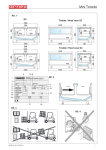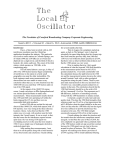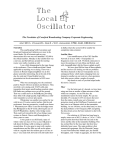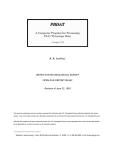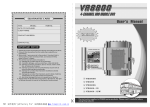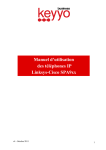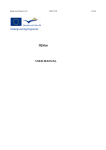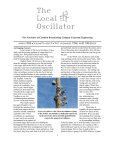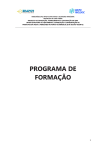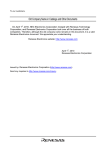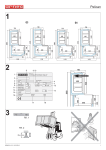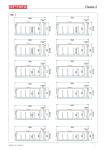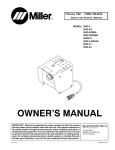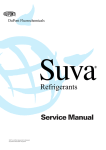Download Review of calculation programs for supermarket DX refrigerating
Transcript
Review of calculation programs for supermarket DX refrigerating systems year-round energy consumption S.M. van der Sluis, M.Sc. IIR/IIF D1-subcommission “Refrigerated Display Cabinets” Glasgow (UK) Meeting, August 31st, 2004 1. Introduction Calculating the year-round energy consumption of a complete supermarket refrigerating and freezing system is generally a tedious job. First of all, there are generally more refrigerating systems at various evaporation temperatures (at least one for freezing and one for cooling), possibly with different refrigerants. Secondly, varying outdoor temperatures throughout the year need to be taken into consideration for a realistic energy consumption estimation especially for systems with floating head pressure (variable condensing temperature). And last but not least, numerous individual refrigeration loads – display cabinets, storage rooms and others – must be taken into account, for each of which proper data must be collected regarding refrigeration load and electrical power consumption (as usually the electrical consumption for cabinet lighting, fans, defrosters etc. is regarded as part of the refrigeration system energy consumption). It is therefore quite helpful, that computer programs have been developed to assist in the calculation of year round supermarket refrigeration system energy use. Recently, three such programs have been introduced to the refrigerating community for the calculation of year-round energy consumption of supermarkets. These are, in alphabetical order: “Cybermart”, created by KTH in Sweden [1]. “Econu Koeling”, created by TNO in The Netherlands [2]. “The ORNL Supermarket Spreadsheets”, by ORNL, USA [3]. These programs are available for free, and can be run on a normal desktop computer with Windows ™ operating systems. The ORNL spreadsheets further require the availability of Excel® as a platform to run them. The programs currently still bear “national” characteristics (such as weather databases, component data and / or language used) but are expected to outgrow this stage in the near future. At the Ecole des Mines in Paris another program, called Clim Top [4] was developed by M. Orphelin and D. Marchio, but regrettably this program has not been released for use by the general public. Although the task of calculating energy consumption may look quite straightforward, and the general approach taken in these three programs is similar, the programs are quite different in their actual use, depending on the various aims and target audiences for which the programs have been developed. For the end-user, this also means that the choice for “the right program for the right job” should be made on the basis of knowledge of the “ins and outs” of the different programs. This review intends to present the three programs in such a way that the user can decide which program is most suited for his specific purposes. 2. Scope of the programs The aim and target audience for the different programs as defined by their producers determine to a large extent what the user can expect from them. - Jaime Arias of KTH, the Technical University of Stockholm, describes his program as follows: “CyberMart is a user-friendly computer model where different refrigeration system for a supermarket can be compared in detail with focus on energy usage, environmental impact (TEWI) and LCC (Life Cycle Cost)”. In fact, the Cybermart program encompasses much more than just a calculation of the refrigerating and freezing system; it also takes account of the HVAC (Heating, Ventilation and Air Conditioning) energy consumption of the supermarket. It also accommodates pricing info on equipment, so that an LCC (Life Cycle Cost) comparison can be made between two alternative system solutions. There are a number of system configurations that can be used in Cybermart, each of which is presented to the user by a system design drawing: i. Direct system (DX for cooling and for freezing) ii. Completely indirect system (Cooling and freezing indirect) iii. Partly indirect system (DX on cooling and freezing side, indirect condensers) iv. Cascade A or B (sometimes referred to as Booster system, freezer cascade condenser is load in the indirect cooling system) v. Parallel system with subcooling (someties referred to as Booster system, subcooling of freezer system is performed by cooling system) vi. District cooling (cascade condenser to district cooling system) figure 1: Cybermart system design presentation (Cascade system B). - In The Netherlands, supermarket equipment investors wanted a tool to compare offers from different suppliers not only concerning price, but also concerning energy costs. The program has been set up based on agreement on methodology between the major Dutch refrigeration system suppliers: Carrier, Fri-Jado (Elficold), Smeva (Linde) and Veld Koeltechniek (Arneg). “Econu Koeling II is an instrument to compare offers for (supermarket) refrigeration installations from different suppliers in a uniform manner. Econu Koeling II calculates the year round energy consumption based on details given in the offer”. The basic idea is that of a “post-processor”, which transforms an offer received from a supplier into an energy consumption figure. The program is explicitly not intended for system design studies, and does not accommodate any “exotic” system designs. It is mostly suited for DX systems and booster systems (where the freezer cascade condenser is a load to the refrigeration system) and it can accommodate indirect systems. The program background was presented at the NTCR 2001 conference [5]. - Steve Fischer presented his spreadsheet calculation program during the international congress of refrigeration in Washington (2003) during a workshop, at which free copies of the spreadsheets were distributed [6]. He wrote: “The ORNL Supermarket Excel® spreadsheets have been developed as tools to assist supermarket planners and engineers to compare the relative energy and refrigerant requirements for alternative designs of their refrigeration systems”. The program can accommodate both Direct Expansion (DX) and indirect systems. An advantage for American users is that the program can be used with English units as well as with SI units. The fact that the program is set up in Excel requires some basic knowledge of excel spreadsheets; it also allows the more experienced Excel user to access the program code. Concerning the target audience, program developers tend to be optimistic as to whom would be the future users of the program. Truth is, that as soon as piping diameters, defrost heating power and minimum condensing temperatures come into view, the use of the program is quite restricted to refrigeration system engineers, refrigeration consultants and, of course, researchers. This is just as true for all of the three programs described here. 3. Calculation methods When it comes to the calculation method for the energy consumption of a refrigeration system, the basics are quite straightforward. Condensing and evaporating conditions determine, over the compressor characteristics, the cycle efficiency. The compressor energy consumption is then determined by total refrigeration load and cycle efficiency. Condensing conditions Condensing conditions are dependent on ambient conditions. All three programs use a scheme in which the calculations are made at various ambient temperatures, and the results are integrated over the occurring ambient temperatures. Cybermart uses hourly values of ambient conditions, in a format that is quite commonly used in HVAC system calculations. Ambient conditions are available for a number of Swedish cities, and for Amsterdam. Ambient temperature distributions - Cybermart 1200 Frequency (hours/year) Stockholm Amsterdam Göteborg 0 -20 -10 0 10 20 30 Ambient temperatures ºC figure 2: example of Cybermart’s ambient temperature distributions The condensing conditions can be specified in Cybermart inside the “Heating and Air Conditioning” input screen; where there is a choice between “heat recovery” mode and “floating condensing” (not diversified for cooling and freezing system). In the heat recovery mode, the user can specify a fixed condensing temperature. In the “floating condensing” mode however, there are no further input possibilities for condensing to ambient temperature difference or for minimum condensing temperature. Subcooling of the refrigerant cannot be specified. The total yearly energy consumption calculated by Cybermart is the sum of 8760 individually calculated hourly values, each at the appropriate ambient condition. Econu Koeling II has no choice of ambient conditions: for all calculations, the same distribution of ambient temperatures is used; which is a reflection of the program’s purpose to compare different solutions at identical boundary conditions. The outdoor temperature distribution used is a typical long term average for the Netherlands. The ambient temperature spectrum is divided in a number of 2 ºC intervals, each with it’s own number of occurrences in a year. The energy calculations are made at the central temperature of each interval, and then multiplied with the number of occurrences. In Econu Koeling II the condenser of each installation (cooling or freezing) must be specified at the design point. Furthermore the minimum condensing temperature must be specified, in case of constant condensing pressure (such as would be used with condenser heat recovery) the minimum value is chosen equal to the design value. In the calculations, the actual temperature difference is related to the ratio between actual condensing load and design condensing capacity. Condensing temperature (ºC) Econu Koeling II condensing curves 60 50 40 30 20 Full load design (example): T = 15K at 40ºC ambient Tc(min) = 20 ºC 10 0 0 10 20 30 40 Ambient temperature (ºC) figure 3: example of Econu Koeling II condensing temperature curves The ORNL supermarket spreadsheets use the same approach as Econu Koeling II, using temperature intervals with occurrence distribution, when it comes to the treatment of varying outdoor conditions. However, the user can choose from a large number of American cities for which climatic conditions are available. It is possible to supply the minimum condensing temperature, and the condenser approach temperature for low temperature (freezing) and medium temperature (cooling) systems separately. Dry Bulb Yearly Temperature distribution 1500 Probability Olympia (ORNL) Econu (Nl) 0 -20.0 -10.0 0.0 10.0 20.0 30.0 40.0 Temperature (Celcius) figure 4: example ambient temperature distribution from the ORNL spreadsheets (Olympia, USA) and the Econu Koeling II temperature distribution. Loads – Cabinet selection. Loads in a supermarket environment are refrigerated cabinets, freezer cabinets, storage cells and sometimes other loads such as air conditioning loads. Generally, many individual loads are present in the form of individual display cabinets. Here a distinction is made between “plug in” cabinets (with an integrated refrigeration system, discharging heat into the supermarket) and “remote” cabinets, which are connected to the central refrigeration systems. Plug in cabinets are irrelevant in the refrigeration calculations; but both Cybermart and Econu koeling II allow their specification, whereby the (direct) electric energy consumption is added to the total yearly energy consumption. Cybermart comes with a database of some 180 cabinets (including minor variations in length and temperature) of brands Carrier and Wyca. To choose from, the cabinet brand and type are presented, more detailed data is not visible to the user during cabinet selection. Length and refrigerating capacity of the cabinets are presented in an overview of selected cabinets, also the overall capacity for freezing and cooling is presented. Storage cells, for medium or low temperature, can be designated by size (area) and storage temperature. Additional display cabinets can be created by the Cybermart user external to the program, by specifying the detailed cabinet data in a text file. The cabinet is then specified in terms of length, refrigerating capacity, evaporating temperature, product temperature, in/out air temperatures, direct electrical consumptions (lighting, fans, defrost, others), in/out brine temperatures and pressure drop. It is possible to designate overall “night cover” usage in Cybermart for the low temperature cabinets and for the medium temperature cabinets in the system design screen. Cybermart allows a quite precise designation of opening hours during weekdays and weekend days, combined with store temperatures during opening and closing hours in winter and summer. This allows for a perfect correlation of night cover use and store temperature. Econu Koeling II comes with a database containing all cabinets from the Eurovent Directory of Certified Products ( www.eurovent-certification.com ). The cabinet data in the Eurovent certification scheme is presented by the manufacturers, and certified by Eurovent by means of laboratory measurements. 10 large manufacturers are participating in the certification scheme. Currently the certified data is limited to positive temperature cabinets. Table 1: Eurovent (remote) cabinet categories (for details and definitions refer to www.eurovent-certification.com). Category Designation • • • • • • • • • • • • • • Family Horizontal, Chilled, Serve-over counter - 3M1 - no night cover RHC1 Horizontal, Chilled, Serve-over counter - 3M2 - no night cover RHC1 Horizontal, Chilled, Open, Wall site - 3M1 – no night cover M-package temperature class 3M1 Night cover N List 3M2 N List RHC3 3M1 N List Horizontal, Chilled, Open, Wall site - 3M2 – no night cover RHC3 3M2 N List Vertical, Chilled, Semi-vertical - 3M2 – no night cover RVC1 3M2 N List Vertical, Chilled, Semi-vertical - 3M2 – with night cover RVC1 3M2 Y List Vertical, Chilled, Semi-vertical - - no night cover RVC1 H2 N List Vertical, Chilled, Semi-vertical - - with night cover RVC1 H2 Y List Vertical, Chilled, Multi-deck - 3M1 – no night cover RVC2 3M1 N List Vertical, Chilled, Multi-deck - 3M1 – with night cover RVC2 3M1 Y List Vertical, Chilled, Multi-deck - 3M2 – no night cover RVC2 3M2 N List Vertical, Chilled, Multi-deck - 3M2 – with night cover RVC2 3M2 Y List Vertical, Chilled, Multi-deck - - no night cover RVC2 H2 N List Vertical, Chilled, Multi-deck - - with night cover RVC2 H2 Y List For cabinets not included in the Eurovent database, Econu Koeling II offers the possibility to add cabinets in a second “user” database. The data to be specified is equivalent to the Eurovent convention, which closely relates to the European test standard, and is defined in Eurovent recommendation REC 05. The user database contains a number of predefined cabinets, which reflect “European average” cabinets. Cabinet data is available for 2,50 meter length cabinets, after selecting the appropriate brand and type from the list in Econu Koeling II the user only has to specify the actual cabinet length. All cabinet data (from the database) is visible when selecting cabinets, including the energy label designation (A-G) for Eurovent cabinets [7]. The data is presented at standard European test conditions, climate class 3 (room temperature 25 ºC, 60 % relative humidity). Internally, Econu Koeling II uses a fixed indoor temperature of 19 ºC, which was a common choice by the Dutch suppliers and cannot be changed by the user. This reflects the purpose of the program, which is to compare the energy consumption of competing offers at fixed boundary conditions. The cabinet data from the database (specified at 25 ºC) is internally adjusted for a room temperature Troom of 19 ºC. Based on the (internal) circulation air temperature Tcirc. in the cabinet the heat extraction rate is adjusted by (Troom-Tcirc)/(25-Tcirc). There is a further option in Econu koeling II to specify additional lighting for each individual cabinet, as in the field extra lighting is often installed. This extra lighting has an influence both on the Direct Electrical Consumption (DEC) and the refrigeration load, as most of the dissipated heat is removed over the refrigeration system. The ORNL supermarket spreadsheets contains 5 predefined low temperature and 8 predefined medium temperature loads, in terms of refrigerating capacity. For each of these predefined loads, the refrigerating load can be set to low, average or high. Because the ORNL program is a spreadsheet program, the user can access these predefined settings (sheet: central manager, display case energy use) to use his own data set or to account for night cover use, differing indoor temperatures and such. All direct electrical consumptions (fans, lighting, heaters and defrost) have to be supplied individually per cabinet by the user –which is quite some work for larger numbers of loads. Table 2: ORNL Supermarket spreadsheet loads data. ORNL Loads data Deli, Cheese, and Pizza Meat and Seafood Multi-Deck w/ Doors Open Multi-Deck Other Display Cases Produce Tub or Coffin Walk-In Cooler/Freezer Medium Temperature kW/m or kW/m2 High Average 0.4326 0.6008 0.2884 0.6008 0.5768 0.6248 1.5138 1.9226 0.8892 1.5861 0.6729 0.9373 0.2644 0.3124 0.2365 0.3154 Low 0.3365 0.0961 0.5287 0.9613 0.4326 0.3605 0.2403 0.0079 Low Temperature kW/m or kW/m2 Average High Low 0.5768 1.3698 0.7450 0.7931 1.3698 0.9613 0.3365 1.3698 0.5287 0.4806 0.2681 0.6729 0.3469 0.2644 0.2365 Evaporating conditions In the past, it was quite common to use -10 ºC for medium temperature cabinets and -35 ºC for low temperature cabinets. In recent years however, requirements on energy efficiency have led to a more diversified landscape, where manufacturers suggest higher evaporating temperatures for specific cabinets where possible. In Cybermart and in Econu Koeling II the evaporating temperature is specified for each cabinet individually, in Econu Koeling II default values of -10 ºC for 3M1 and 3M2 cabinets are used in the database when no specific manufacturer’s details are available, and -8 ºC for 3H cabinets. When cabinets with different evaporating temperature requirements are connected to one rack, Econu Koeling II sets the evaporating temperature to the lowest required temperature. For the other cabinets (with higher evaporating temperature requirements), there is an option to specify the use of an evaporating pressure controller. When this is used, the cabinet will operate at it’s prescribed evaporating temperature, and no correction to the refrigerating capacity is made. When the controller is not selected, the program recalculates the cabinet data to operate at a lower evaporating temperature than described, which means that the refrigerating capacity is increased (due to lower circulating air temperatures and more air dehumidification). All three programs have an option to use more than one compressor rack. From an energy efficiency viewpoint it is advisable to group cabinets per compressor rack according to their evaporating temperature. In this way, cabinets which allow high evaporating temperatures can also be operated (efficiently) at these high temperatures, and are not operated at a too low evaporating temperature that may be required by other cabinets in the same group. In the ORNL supermarket spreadsheets, the user can specify the evaporating temperature per rack. The cabinet superheat in DX systems is set to a default value of 9K in Econu Koeling II. There is an option (per rack) to reduce this value to 5K, to reflect the use of electronic expansion valves. Suction line losses Cybermart has been developed for applications with indirect cabinets, and has a program module to calculate the pressure drop in the brine system. Also for DX applications, a pressure loss module is used. For each compressor rack, the geometry data (length, diameter, elbows, others) has to be supplied for liquid, suction and discharge lines. Velocity, pressure drop en temperature are then calculated by the program. The ORNL spreadsheets use the same approach, but to a greater detail. Here, for each single cabinet or other load, the individual branch piping lengths have to be specified as well. Due to this setup, the number of loads per compressor rack is limited to 10. figure 5: refrigerant line characterization in the ORNL spreadsheets (1=main liquid line, 2=branch liquid, 3=branch suction, 4=main suction, 5=suction return) Econu Koeling II takes a completely different approach: suction line pressure drop is not calculated, but quite simply an assumed value of 2K equivalent is used in all calculations. Refrigerant circuit and compressors Development of the three programs has been started before the breakthrough of CO2 in supermarket refrigeration systems. Therefore, none of the programs is suited to make calculations for CO2 cascade or supercritical refrigeration systems. Cybermart is at the moment limited in the choice for refrigerant and compressors; it uses refrigerant R 404A and allows a choice out of three compressors (Bitzer reciprocating, Copeland reciprocating or scroll) for the medium temperature system and for the low temperature system. Info on compressor performance data is not accessible to the user. Econu Koeling II allows a choice of refrigerants from a predefined list, which includes the most commonly used refrigerants in supermarket refrigeration (R404A, R407C, R507, R134a, R290, R410A, NH3). For each rack (2 medium temperature, 2 low temperature) the user can specify up to 4 compressors (from a database) and can indicate the configuration: parallel compressors without or with frequency control. The compressor database in Econu Koeling II is pre-filled with Bock and Bitzer compressors for R404A, R407C and R507. The user may add additional compressors to the database, whereby the data to be supplied is data under standard test conditions. There are easy to use input screens per manufacturer for data supply, which reflect the terminology and representation as used in the manufacturer’s technical documentation. The compressor data, available in the database at standard test conditions (for example at -10 ºC 25 ºC suction gas temperature) is recalculated by Econu Koeling II during run-time to fit the actual conditions in the specified rack (for example -12 ºC evaporating and -2 ºC suction gas temperature). The ORNL supermarket spreadsheets use a polynomial to determine compressor COP based on saturated discharge (condensing) temperature and saturated suction (evaporation) temperature. The polynomial used corresponds to the Copeland 4DT3=2200 Discus compressor. Because of the spreadsheet nature of the program, it is possible to make use of alternative compressor data, which however requires that 2 tables (capacity, power) with each 72 values are specified. Table 3: Overview of calculation specific details. Cybermart - DX - Indirect - Indirect condenser - Booster (cascade) - Freezer subcooling - District cooling Ambient temperatures Calculation Condensing conditions Subcooling Indoor temperature Predefined cabinets Add user cabinets Cabinet DEC Nightcovers Additional lighting Brine system calc. Evaporating temp. Superheat Suction line P # of racks Refrigerants Predefined Compres. Add user compressor Econu Koeling II Units SI SI Systems + + + ≈ + + + + + Condensing conditions 16 Swedish cities Dutch profile Hourly values Temp. intervals Fixed Tc or floating Design Tc, Tcmin, Capacity, Pfan, Yes, option Indoor conditions Choice day/night and Fixed 19 ºC winter/summer Cabinets 180 Swedish cabs. Eurovent directory Possible (txt file) Possible (program) + (fan/light/def, ..) + (DEC 12h lighting) All medium temp. All Individual per cab. low temp. cabs. + + Evaporating conditions Per rack, automatic Per rack, automatic Not available 9K (option EEV: 5K) Suction line losses (DX) Calculation Constant 2K Refrigerant circuit & compressors Unlimited 2 medium, 2 low R404A 1 Bitzer, 2 Copeland Not available ORNL spreadsheets SI or English Units + + - T 7 refrigerants All Bock & Bitzer (404A, 407C, 507) Data entry screens 237 USA cities Temp. intervals Tcmin, T Pfan Supply line T Not available +(fan/light/def/heater) ≈ + + User input per rack Not available Calculation 3 medium, 3 low (max 10 loads/rack) Not available 1 Copeland Discus 144 tabulated values Reporting The reporting section in Cybermart is set up as a report on the whole supermarket energy situation, including the HVAC system. This implies that the refrigeration specific reporting details are quite minimal; there is however an interesting plot of year-round compressor power consumption which can be used to determine peak compressor power requirement. Total Cooling rack Freezing Ambient figure 6: compressor power plot from Cybermart . Econu koeling II provides only textual reporting of energy consumption per rack, and the split-up of energy use over compressors, condenser fans, direct cabinet consumption and others (plug-in cabinets). The program can also print an extensive report of the complete calculation, including all the input data (with cabinet list, compressor specs etc) as well as results. The ORNL supermarket spreadsheets provide reporting facilities, in which 10 different runs (calculated results) can be easily compared in regard to energy consumption and refrigerant charge in a graphical representation. The results are also available in tables, the nature of the program (Excel) allows unlimited other representation forms. figure 7: ORNL supermarket spreadsheet energy consumption display for 10 calculation runs. Validation A validation of a calculation program for supermarket year round energy consumption in the true sense, is to make a calculation of energy consumption based on knowledge on location, building and equipment – without previous knowledge on measured values. Then, the calculation result is compared to actual measurements, preferably for a number of supermarkets. A validation in this sense has only been performed for Econu koeling II, even though this program is explicitly intended for comparison of offers for refrigeration installations with regard to energy consumption, and not for predicting actual energy consumption. The validation for Econu Koeling II was performed on 3 supermarkets; two in The Netherlands and one in Germany. Supermarket 1 is a “C1000” supermarket in Amsterdam with 1360 m2 sales area, where energy consumption for refrigeration has been monitored for 4 years. The market has 63 m. positive temperature cabinets, 20 m. frozen display and 8 storage cells. It has a floating condensing temperature (minimum 24 ºC) and active liquid subcooling for the freezer section. Energy consumption calculated with Econu Koeling V2 for this supermarket was 351 MWh/year, which is 1% below the actual average measured value. Table 4: Measured energy consumption data for 1360 m2 supermarket (used for validation). Measurement Period April 2000- April 2001 April 2001- April 2002 April 2002- April 2003 April 2003- April 2004 Average 4 years Energy Consumption (kWh/year) 353500 357500 353000 356000 355000 The supermarket chain’s advisor (DN Consultancy) used his own calculation method in projecting the installations, and arrived at a yearly consumption of 360.000 kWh/year – which is also a quite accurate prediction of the actual measured energy consumption. Supermarket 2 is a “C1000” relatively new supermarket in Nieuwegein with 968 m2 sales area, where energy consumption for refrigeration was monitored from may 2003 – may 2004. The measured energy consumption over this period was 200.000 kWh. In this case, the supermarket chain’s advisor had projected the installation at an energy consumption of 225.000 kWh/year. The consultant explained, that this market was operated by an “energy minded” owner, who consistently used the available night covers and operated at a low store temperature. Econu Koeling calculated an energy consumption of 255 MWh/year for this supermarket, which is 28 % above the actual measured value (and 13% above the value predicted by the advisor). It must be noted that Econu Koeling calculates energy consumption at fixed boundary conditions, and does not take account of the actual situation, such as a lower store temperature. The last validation project for Econu Koeling V2, Supermarket 3, is a German “Extra Markt” located in Rheinberg. For this market Econu Koeling V2 calculated a yearly energy consumption for refrigeration of 762 MWh/year. This value is within 1% of the actually measured energy consumption. For the ORNL supermarket spreadsheets, extensive measurements were made in a large supermarket with 6 refrigeration racks. These measurements were however used for parameter fitting as well as for comparison of results, and can therefore not be considered as a validation in the true sense. The results are listed in the table below. Table 4: ORNL supermarket spreadsheet validation (after fitting). Program Manuals The manual for Cybermart is available in PDF format, and through the help function internal to the program. The manual describes how to operate the program, but gives no details concerning the calculation methods used. The Econu Koeling II user manual gives a combination of operating instructions and description of the program. It is available through the program’s help function. The ORNL supermarket spreadsheet manual is quite extensive, and gives detailed information on the calculation rules used. It is available as a separate PDF document. For general use of the spreadsheets, the manual is very complete; for creative use of the spreadsheets – with additional programming by the user – it is necessary to have a good knowledge of Excel. It is almost impossible to cover in a manual all the things a user might want to know. It is therefore quite positive, that in my experience the programmers have answered swiftly and helpful to questions posed by email or telephone. Conclusions. Which one of the three programs for calculation of supermarket yearly energy consumption is most suitable, depends highly on the users purpose. In the design stage, when one wants to make an energy efficient system choice for the supermarket as a whole including the HVAC system, Cybermart is definitely the right choice. For time saving calculations to compare energy use of standard DX systems, with minimum need for user input of technical data, Econu Koeling II is very well suited. By nature, the ORNL supermarket spreadsheets offer maximum flexibility and are thus best suited when special features need to be calculated, as the spreadsheets allow access to every formula used. Literature [1] [2] [3] [4] [5] [6] [7] Cybermart Beta-Version, Jaime Arias, KTH Sweden. July 2004. Econu Koeling V2 test version, Sietze M. van der Sluis (TNO) and Henk Stijnen (DWA) for NOVEM and CBL, The Netherlands. August 2004. The ORNL Supermarket spreadsheets, Steve Fischer, Oak Ridge National Laboratory. CD ROM distributed during the 21st International Congress of Refrigeration, Washington DC USA, August 17-22, 2003. Computer aided energy use estimation in supermarkets. M. Orpelin & D. Marchio, Centre d’Énergétique de l’Ecole des Mines de Paris. Proceedings of Building Simulation ’97, Volume 2: 213-220 A Method for Comparing Refrigeration Offers for Supermarkets, S.M. van der Sluis. IIR Conference „New Technologies in Commercial Refrigeration”, University of Urbana Champaign, Illinois USA, July 22-23, 2002. Proceedings ISBN 2-913149-27-8 Short Course SC12: Advances in Supermarket Refrigeration, S. Fischer et al., 21st International Congress of Refrigeration, Washington DC USA, August 17-22, 2003. Proceedings ISBN 2-913149-32-4 Experience with a voluntary energy labelling scheme for refrigerated display cabinets. S.M. van der Sluis. 20th International Congress of Refrigeration, Sydney Australia, September 1924, 1999. Proceedings ISBN 2-913149-06-5














